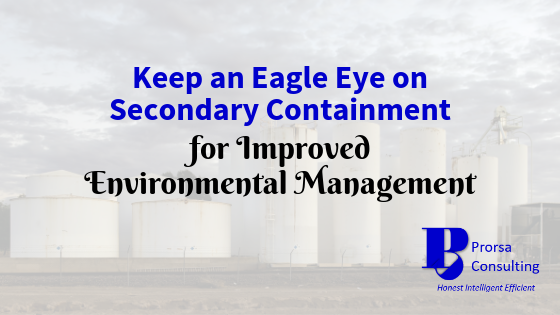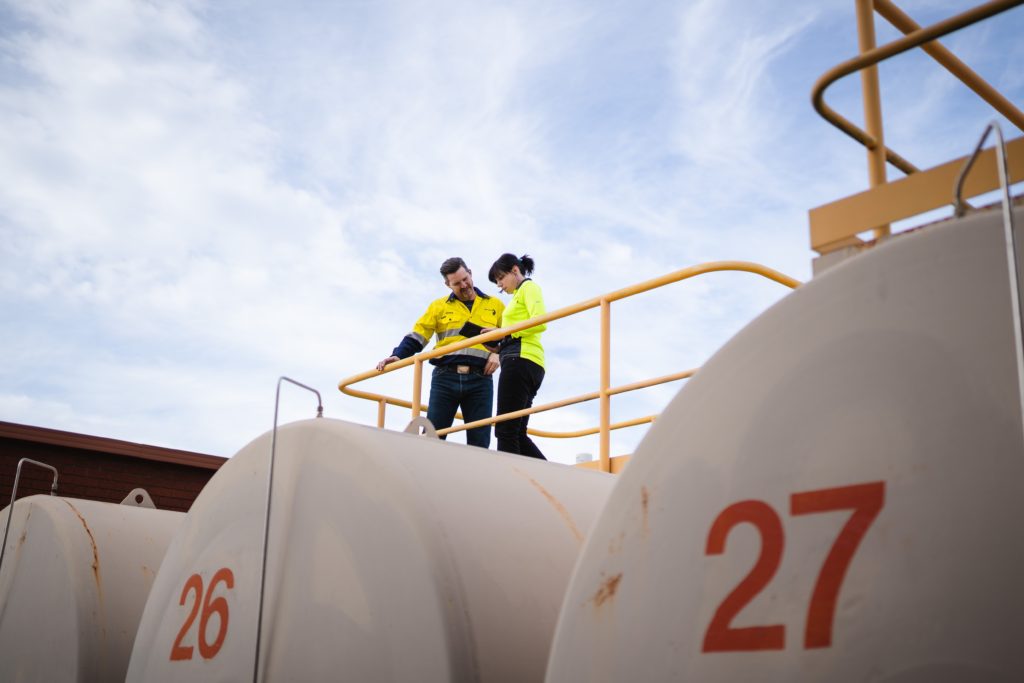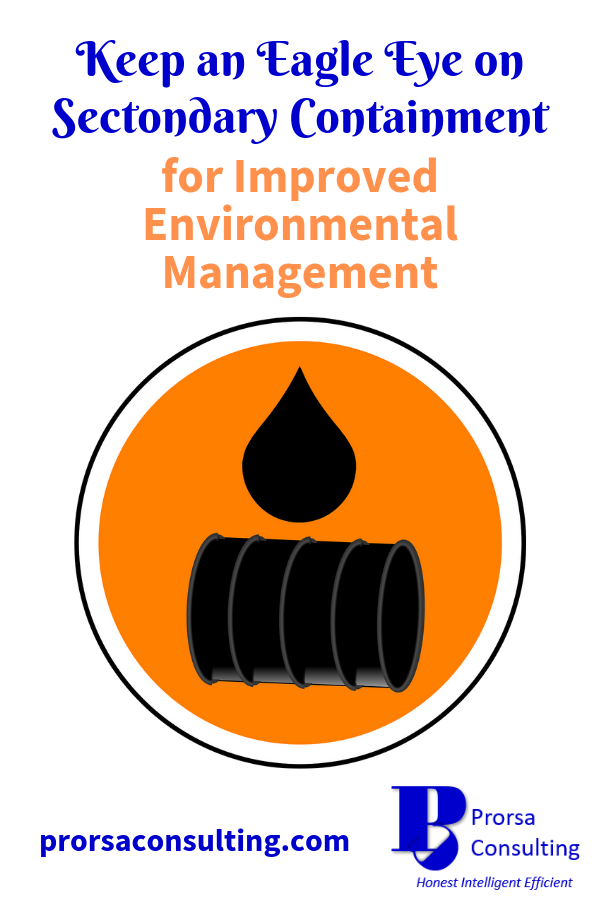Keep an Eagle Eye on Secondary Containment for Improved Environmental Management
By : Admin -

Secondary containment should not be ignored if robust environmental management is the goal.
At just about any time the potential exists for a storage container to fail, and secondary containment structures provide the best line of defense to prevent danger to persons and the environment when these failures occur.
Yet, non-existent or poorly maintained containment is like having no containment at all in an environmental management program.
Continue reading to explore some basics and best practices for secondary containment.
Please be aware that this blog post may contain affiliate links and any purchases made through such links will result in a small commission for Prorsa Consulting (at no extra cost for you). Feel free to visit our Disclosure of Material Connection page for more information.
Secondary Containment Basics
What materials should be stored with containment?
When many individuals think of secondary containment requirements, storage of oils and oil-containing products usually come to mind first.
The U.S. Oil Pollution Prevention regulations found at 40 CFR 112 outline the obligations around secondary containment for oils.
Moreover, hazardous substances such as chemicals and wastes should also be stored behind secondary containment.
Secondary containment guidelines for hazardous waste treatment, storage, and disposal facilities can be found at 40 CFR 264.
While all these materials should be managed to prevent potential pollution from any sized spill, the secondary containment requirements primarily focus on larger, bulk storage containers.

Image by Dave Morgan on Pexels.com.
What are some examples of secondary containment?
Facilities can utilize a variety of solutions for secondary containment.
Furthermore, some containment structures must be designed, while others can be purchased and used “as is” straight from the distributor.
Concrete bunkers, metal or plastic bermed/diked areas, double-walled tanks, spill pallets, etc. can all function as appropriate secondary containment for chemical storage.
Facilities should strive to select the type(s) of containment that works best with site conditions and environmental management goals.
What is an appropriate size for a secondary containment structure?
Generally, secondary containment requirements mandate a structure capable of holding 10% of the total stored product volume or the volume of the largest container, whichever is greater.
If the chemical storage area is located outside, the secondary containment structure should also accommodate sufficient additional volume for precipitation.
Hazardous waste regulations identify that secondary containment should hold at least 110% of the largest container.
Rule of thumb can dictate a containment volume as large as 150% of the largest container.
Most important during the selection and/or design of secondary containment structures, facilities should ensure the chosen structure(s) will prevent the release of materials beyond the containment boundary for enough time to implement proper spill cleanup measures.
Secondary Containment Best Practices
Containment Selection
In addition to pondering best fit for site conditions, facilities should give consideration to a few other aspects during the selection process when implementing best practices.
First, to prevent leakage and contamination, containment must be impervious.
Proper containment cannot occur if the barrier allows flow-through or infiltration.
Subsequently, the containment structure should be constructed to be durable in order to reduce the chances of failure.
Less durable containment barriers for chemical storage may not always perform as intended and also tend to carry more frequent replacement costs.
Furthermore, the structure also must exhibit compatibility with the products stored inside the containment.
Sites only benefit when they strictly avoid the creation of an additional environmental or safety hazard from an incompatibility.
Regular Inspections
Regular inspections should always be performed as secondary containment best practice.
Finding potential issues early allows for proactive rather than reactive environmental management.
Moreover, taking advantage of opportunities identified during inspections can assist in keeping operational costs lower.
When conducting an inspection, a few areas should receive heightened attention.
Place inspection focus on any damage to the structure possibly compromising the containment’s ability to contain a spill.
Structural flaws and weaknesses only raise the probability of an unexpected containment failure in the chemical storage area.
Additionally, note any housekeeping issues as trash, debris, etc. inside the structure.
Items like these only serve to reduce the effective capacity of the containment and should be removed in a timely manner.
Finally, any standing precipitation within secondary containment should be documented.
Draining of precipitation should occur when necessary to maintain the effective capacity of the containment structure.
Moreover, precipitation captured by a secondary containment structure must be checked prior to release to ensure it has not become contaminated.

Image by Start Digital on Unsplash.com.
Inventory Checks
Another secondary containment best practice is periodic inventory checks.
As stated previously, containment should be compatible with the materials stored and adequately contain the spill volume should a primary container fail.
Inventories often change with time, and facilities may add new materials or purchase larger/lesser quantities for use in the operation.
For materials needing storage within secondary containment, inventory quantity and chemical characteristic reviews help to ensure sufficient containment and compatibility.
These types of reviews should occur on a fairly regular basis to maintain the best environmental management possible.
Alternatively, a facility may opt to implement a chemical review by EHS personnel as part of its procurement process before making purchases.
Timely Cleanup of Spilled Materials
When a spill does occur within secondary containment, it has the same effect as trash or debris.
The effective volume of the containment structure is reduced, increasing the potential for overflow should another primary container fail.
As such, cleanup of spilled materials should commence in a timely manner as a best practice.
Train employees to look for and report spills in and around chemical storage areas during their daily workplace inspections/examinations.
Furthermore, employers can empower workers to clean up spills, when it is safe to do so, without prompting or other intervention from supervisors.
Last but not least, dispose of utilized cleanup materials in accordance with environmental regulations and the relevant instructions provided on the spilled chemical’s safety data sheet.
Program Administration
As with other areas of an environmental management program, good program administration helps to promote success.
Robust administration will keep the other secondary containment best practices current, relevant, and effective.
Sites can start with making certain employees receive proper training on containment structures and spill cleanup procedures.
Businesses can’t expect workers to be able to inspect, correct conditions, or respond to spills without the proper knowledge.
Moreover, facilities must ensure spill response procedures remain updated.
This will allow workers access to the proper most up-to-date process for spill cleanup should the need arise.
Finally, sites should have sufficient spill cleanup materials located in or close to areas most prone to spills (i.e. areas with chemical storage).
Cleanup materials must be readily accessible by employees.
Companies need to monitor these supplies periodically and replenish the stock as necessary.
Parting Thoughts
Secondary containment serves an important function at any facility.
As such, a command of secondary containment basics and best practices is a must for stellar environmental management.
Knowing the basics and implementing best practices consistently will help with pollution prevention and keep these controls ready to function as intended in the event of primary container failure.
Related Posts for You
Are Your Ducks in a Row for Tier II?
7 Fantastic Tactics to Quickly Tame Your TRI Reporting
Reduce Risk and Instantly Master Stormwater Compliance with 5 Essential Strategies
SPCC Regulations: Know the Applicability Rules for Lasting Compliance
We encourage your feedback on this blog. Be sure to like and/or share below if you enjoyed the content. You can also provide us with feedback via our Contact Us page.
Don’t forget to follow Prorsa Consulting on LinkedIn, Pinterest, and Twitter!
How would you like to have access to additional, exclusive EHS updates and info from Prorsa Consulting? Just signup for the Prorsa Consulting Newsletter below. You’ll get access to our Free Resources area and all the tools, templates, and presentations in the library. Subscribe for free today!
Keep an eagle eye on secondary containment for improved environmental management.





